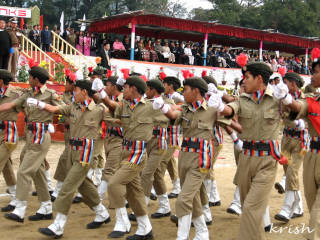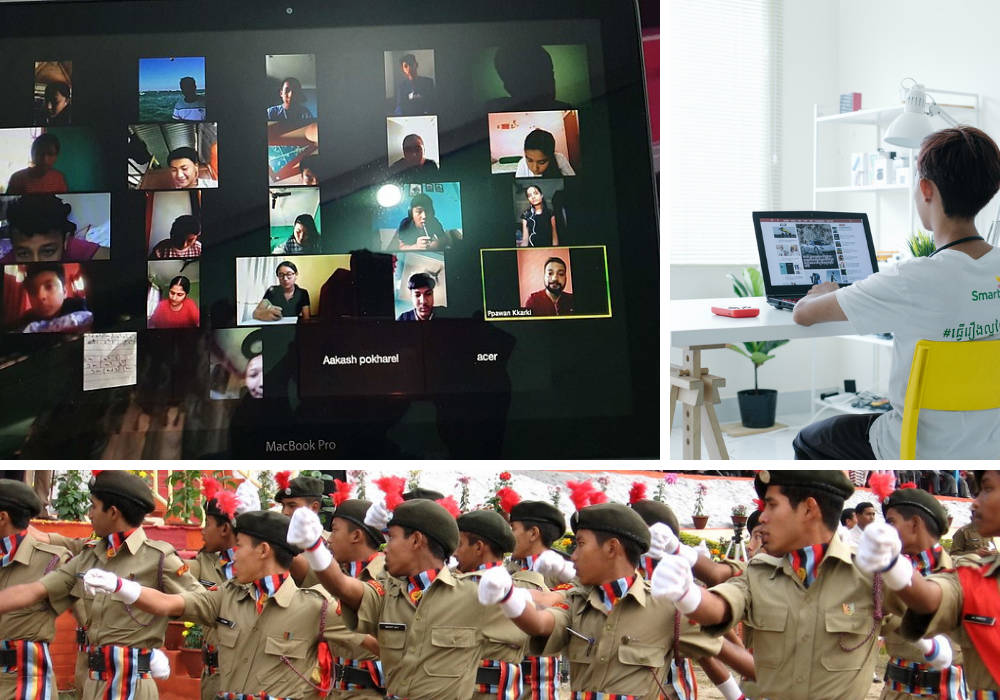[Photos by (clockwise from top left) Sanskar Dahal, CC BY-SA 4.0, via Wikimedia Commons; SCREEN POST on Unsplash; Krish, CC BY-NC-SA 2.0, via Flickr (Images are representative)]
Ground Realities is a blog, anchored by the team at Quipper Research, led by its co-founder and CEO, Piyul Mukherjee.
It is an attempt to understand what’s happening inside people’s homes, in their lives. The ups and downs, as reflected in their social and economic world. You can read the entire series here.
By Himal Belwal, Ishani Ray, Nishtha Jaiswal, Saawani Rajadhyaksha, Sharmistha Adyanthaya, Ipsita Bandyopadhyay and Piyul Mukherjee
On the face of it, the Indian education system has been fairly quick to adjust to a new reality of social distancing by adapting to a virtual mode of learning, with ubiquitous apps and smartphones.
In reality a lot of Indian children do not have access to an internet connection. In fact, according to a UNICEF report, only 24% of Indian households have internet facility to access e-education.
Even for those who do have access, the phrase ‘we are all in the same storm but not in the same boat’ could not be more apt. The plight of school going children now reduced to learning in front of a screen is each different and unique.
Over the past year, it has become obvious that the pandemic-driven health emergencies and the discriminating digital divide where schools and students are equally ill-equipped to deal with a changing reality, has resulted in an existential crisis for millions of young adults.
The real culprit appears to be an education and schooling system that has thoughtlessly and lazily, without any creativity and empathy, simply transplanted the traditional mode of physical learning onto the online platform. Students continue to be weighed down by an illogically designed heavy syllabus and rote learning methodology while also having to deal with zero contact with friends and classmates.
What is the personal experience of students who find themselves rudely cut-off from any semblance of academic learning and interacting with classmates?
We deep dive to discover the eviscerating reality of two senior school kids, one from Maximum City Mumbai, who is expected to seamlessly come to grips with the new digital avatar; and another from the mountains of Nainital, who finds himself suddenly without the discipline, routine and rigour of physical school that was to be his conduit to a stable job. We then speak to a teacher from a private school in Jaipur who gives us a view from the other side.
Gaming a flawed system

[By SCREEN POST on Unsplash]
Rahul Patel*, Age 16
An 11th-grade student in junior college (not school). ‘Attends’ a well-known Mumbai suburban educational institution.
Residence: Vile Parle, Mumbai
Family: Lives with his parents. His mother is a homemaker and his father a shop owner seeking to give the best quality education to his only son.
*name changed
It is examination day at one of the best-known commerce colleges in the western suburbs of Mumbai. Teachers begin admitting students into their virtual Zoom exam centre. Students are instructed to keep their cameras on so that the teachers can keep vigil so that they do not refer to their books or notes.
A group of Zoom ‘backbenchers’ far ahead of the technology curve, smartly open a Discord voice chat in the background and start discussing the answers with one another. With a hundred million users worldwide, Discord allows its predominantly teenage audience to engage with one another. A VoIP, instant messaging and digital distribution platform, it is designed for users to communicate with voice calls, video calls, text messaging, media and files in private chats or as part of communities called ‘servers’. Teenagers such as Rahul use Discord to game the examination system.
In spite of being aware that an open-book examination format may prove to be far more effective in a Google-enabled world, schools are unwilling to rock the current archaic system of marks-based performance evaluation.
Rahul lives in a Mumbai suburb and has access to unlimited bandwidth, a latest generation laptop, and a recently launched smartphone. He is your typical savvy tech-native city boy. He and his friends are naturally far ahead of his teachers in understanding and cracking ways to outsmart teaching apps.
“There’s only so much a webcam can see. I can do anything off camera,” Rahul says cheekily. “Plus, I’m on mute. So, if the teacher sees me talking, I can just tell her that I was wanting to ask her a doubt.”
When online teaching became a linear adaptation of offline school, it failed to grab his attention. The current passive mode of learning is not stimulating for someone who has always seen himself to be an all-rounder and a multi-tasker.
For Rahul, his entire college experience has been reduced to tiles on the screen. He doesn’t know any of his teachers or his fellow classmates. He wakes up every morning at 8 am, gives his attendance and shuts off his computer and goes back to bed till noon. Unless he is sitting for an exam along with his old school friends who are also in the same college.
In this virtual environment, the backbencher as he likes to call himself, has found a way to carry on with his mischief and antics behind the teacher’s back. Discord is less about cheating and more about doing something different and figuring out all that the latest apps in the online world allow users to do.
“My dad said, ‘you’re missing out on the best years by sitting at home! You’re not having fun with your friends, you’re not bunking classes, you’re not meeting girls. What is the point in being a teenager?’” Rahul recalls with a shrug.
Junior college is a rite of passage for students in Mumbai, liberated from the regimented structure of school. Just like many others, Rahul had been eagerly looking forward to these two years of freedom. “Last year, I was so excited and looking forward to the 11th,” he says. “My older friends used to tell stories of how they would bunk classes and go to Marine Drive and eat ice cream at Bachelors and hangout late at night.”
Over the past year, schools have had to reconfigure what it means to be an educator in the time of a pandemic. But most of the focus has only been on trying to shift pre-existing systems online instead of trying to adapt and redesign the entire system. When it comes to boys like Rahul, who are vibrant, energetic, out-of-the-box thinkers, the system has no idea how to nurture these traits and make them shine.
During the school years, Rahul would barely finish his breakfast so he could rush out of the door to get to the school bus. He mentions with pride, his sense of ownership of the Pawar Public School at Kandivli where he was one of the first batch of students as the new school came up, participating in the creation of the pillars of the school—the library, the science labs, the PE room.
“I joined Pawar Public School when it was founded in 2010. I was in school for 10 years. I won many trophies for school. I saw teachers coming and going and principals changing. The interiors of the school changed while I was there. I still feel a deep connection with the school. I haven’t even set foot in college, so I feel no connection with it.”
On days when he does log in to his classes, Rahul switches his camera off and spends his time on his phone playing Call of Duty or World of Cricket 2, popular mobile games with youngsters.
Initially, Rahul had been genuinely excited to start studying in college and was hopeful that online college would help him experience ‘real’ college. “I remember the online orientation on the first day of college. It all sounded so exciting, I had all my coloured markers and all, but I gave up as I lost interest.”
To his dismay, even the college fest which he was hoping would be his first physical foray into college, and where he expected to become a volunteer, was moved online due to the prolonged pandemic.
Rahul refuses to let his college years go to waste. Since the system does not stimulate him enough, he decided to find avenues to enrich himself outside the system. In the past year, he has taught himself graphic design online.
“I love it,” his eyes light up, “It’s better than being forced to study.”
He seems to be suffering from what experts are calling Zoom fatigue. A recent survey showed that an estimated 75% of college students have Zoom fatigue. He says that his disinterest also stems from the fact that he has not had any real connections with his college or new batchmates.
Most educational systems have been focusing on the old-world model of completing the syllabus to facilitate exams and have not taken any serious steps to address the emotional issues faced by students. The pandemic has triggered a large-scale mental health crisis among children in India. In spite of teachers and institutions being aware of the toll the new normal is taking on students, there has been no real effort to address the mental well-being of children and young adults to help them cope with the anxiety stemming from the situation.
What is striking about Rahul is that under the fun-loving, joker facade is a young adult with profound wisdom. He believes that the pandemic could not have come at a worse time in his life.
“It should’ve come when I was in the fifth or sixth standard. Earlier it is important to learn to be with others in kindergarten and in primary. And it is equally important for me now in the 11th grade when I could have made so many new friends,” he says.
Young Rahul remains optimistic that things will change for the better in the future. As he sees it, the solution is simply a matter of the college and faculty willing to create a better learning environment. “After all, teachers have the power to do anything. It is their college, their rules.”
The education system in India has failed to think out-of-the-box when going digital and fallen short of channelling the inherent digital intelligence of youngsters like Rahul.
Who has just aced the examination he gave, receiving 100% marks.
Keeping the faith in the absence of second chances

[By Krish, CC BY-NC-SA 2.0, via Flickr]
Harshit Arya, age 17
A 12th grade CBSE Student of Sainik School, 8 km from his home
Residence: Aloo Kheth, Bhowali Road, Nainital, Uttarakhand
Family: His recently widowed mother, Sangeeta, is an Economics honours graduate working as a house-help and younger sister Tanisha is in eighth standard in the local village government school.
Life has never been easy for 17-year-old Harshit. His father, a carpenter by profession, was not much of a role model. The man had spent his sporadic earnings on alcohol. Harshit had watched his mother Sangeeta, an Economics honours graduate, simply give up on her dreams and end up working as a house-help to ensure the family got by.
The previous year, alcohol had finally claimed his father’s life and Harshit realized that he would need to swiftly find a way and work part time to bring a semblance of stability to his family.
His mother’s employees had earlier enabled and encouraged Harshit to join the semi-government Sainik School. This brought his dream of joining the armed forces as a soldier, closer. Harshit thought nothing of the arduous 8-km hike he made each morning, often in the biting winter cold, to reach his school. His pride was immense as he donned the spiffy uniform, put on his socks and boots, and attended a school that was his training ground for a stable future job.
In a life of disarray and uncertainty, the disciplined physical training and routine had become a daily escape for him. He loved hanging out with his buddies and being mentored by his teachers.
“School was so much fun. I miss getting punished by the teachers in school,” he now recalls wistfully.
There is no escape any longer. A pervading sense of uncertainty has once again seeped back into Harshit’s life over the last 15 months.
The main hurdle for Harshit and his classmates was that none of them possessed a mobile device. All the family owned was his late father’s battered old phone. Harshit simply dropped out of school. Luckily for him, he found temporary employment as a cashier in the neighbourhood Patanjali store. Working eight hours each day, Harshit over four months, managed to save up enough to buy a second-hand smartphone and left his job to re-join his school.
At the same time, he continues to struggle with the online teaching mode and recognises the irreversible academic damage when he says “I am missing out on my education.”
His school has grappled unsuccessfully with online teaching. “They simply send us notes on WhatsApp along with assignments.” Students are barely able to understand concepts and have no means to clear their doubts with a teacher. “I could easily have gotten that from any study guide,” feels Harshit, who is expected to complete exercises manually and visit school once every other month to submit his work.
While the smartphone has not helped much in his academic learning, he is glued to it all day. His mother, like any mother of a teenager across all classes, says, “Karta hoga ladkiyon se baat.” (He must be talking to girls.)
The challenges faced by Harshit are pretty much the same as those faced by thousands of other kids like him living in smaller towns and from lower income families who find themselves on the wrong side of the digital chasm that separates the haves and the have-nots. They are the victims of a system that has given little thought to the ground realities, and is grappling with transplanting physical teaching onto the virtual medium.
The school has offered to waive off fees for those who cannot pay, and teachers have offered to chip in with whatever financial aid they can muster. Yet, most either cannot afford a smartphone, nor can they afford the regular recharge of Rs 199. Besides, all of Harshit’s classmates are at the mercy of poor connectivity faced deep in the mountains. These regions also battle with regular 14- to 16-hour power shutdowns, especially during the monsoons.
Harshit’s mother laments not being able to afford a phone for her daughter Tanisha to also attend online classes. She says, “Ab teil bhi 170 ka ho gaya hai. Main inka pet bharoon ya phone loon, ya kya karoon?” (Our cooking oil costs Rs 170. Should I feed them or get her a phone, what am I to do?) The midday meal during the day is now an added expenditure. Both her children used to take their lunch at school.
What is also obvious is the fact that Tanisha’s education is not a real concern for her mother. While Harshit attends the English-medium Sainik School, Tanisha goes to the neighbourhood government-aided free school. The education of a daughter comes second to that of the son. For Sangeeta, Tanisha needs to study enough for her to find a good match. Although Tanisha herself wishes she could become a nurse.
Children across the globe are going to bear the brunt of the pandemic. A Unesco project estimates that 24 million children may not return to education in 2020 due to the pandemic. In India, it is expected that school dropout levels will double compared to earlier. Children have become victims of an education system that has failed them in the Covid crisis.
When the dust settles, perhaps children from privileged homes will have the means to put these flawed years of learning behind them and find their way back to their brightly chalked out futures.
In Harshit’s world, he stoically hopes to find his way around the obstacles in his path. He continues to keep up a brave face and simply refuses to give up on his one shot at a better life. He emphatically says, “No matter what, I will make it into the army. There is no other alternative for me.”
Pulling off e-teaching successfully takes precedence over effective learning

[By Sanskar Dahal, CC BY-SA 4.0, via Wikimedia Commons]
Priyanka Sahni, age 40 years
A teacher for the past 10 years, in a private school in Jaipur, she teaches science to senior grades.
Family: Lives with her husband, who owns a business selling air conditioners and refrigerators and her 12-year-old son studying in an upmarket private school in the city.
Early last year, during the initial Covid outbreak, the faculty at Priyanka’s school in Jaipur had imagined that the situation would simply blow over in a matter of weeks or at most a couple of months. Gradually, as it dawned on them that the pandemic was here to stay, a sense of confusion and uncertainty prevailed, rooted in the lack of any experience whatsoever of virtual teaching.
She recalls the rudimentary start: “We just captured our handwritten notes on our mobile camera with our voiceover reading it out aloud and sent these as WhatsApp messages to the class group.” With the lack of interactive teaching, most kids failed to grasp much of what was being taught. She was aware of this but felt it was beyond her control.
Priyanka’s 12-year-old son Yajat, who attends a prestigious international school that adapted to virtual learning rapidly and seamlessly, came to her rescue. She watched their online classes, the usage of various study apps, and the potential for mass interaction.
She then explained the mode to her school which followed suit, striving to adapt the same format.
The next hurdle was bringing each parent on board with this new way of learning. Parents were now expected and required to invest their time, and it was no longer about the payment of mere school fees.
During the first lockdown last year, Priyanka and others in the faculty undertook the task of personally calling parents of each student in their school, explaining the requirements and logistics of virtual learning. Their efforts initially faced scepticism, with most parents dismissing online learning as unworkable. They believed that students would not be able to gain any real learning through it. The parents too saw this phase as something of a minor blimp that would soon pass.
Priyanka’s school soon learnt the ropes of conducting online teaching and adapted the teaching app Studybase. She laughs when recalling the first day. “It was a disaster. I clicked a button where a student became the host and I had no idea how to fix it. I just kept up a monologue and asked children to introduce themselves to somehow make it through the class.”
Indian middle-class homes rarely gave a cell phone to their children, even those attending high school. More often than not, the hurdle was not the price but the mindset. Priyanka was herself planning to give a cell phone to her son when he entered college. “That’s the usual norm in our family,” she says. Most children were well-versed in the usage of cell phones—via borrowing their parents’ phones.
With online classes becoming a reality, that had to change. Across homes, children owning cell phones has become the new normal. Laptops are not affordable for many homes.
Schools have been under pressure to justify charging the same fees as they did in physical schooling. Their concern naturally has been to fend off any potential complaints from parents.
“The principal warned us that we need to bring our A-game to class every day,” says Priyanka. “It was no longer just us and the students. Anxious parents were often looking over a student’s shoulders and attending classes. Some parents were fairly good at the subjects we were teaching. There was no way we could falter.”
Private schools that charge fees have effectively all aligned themselves with online teaching apps and transplanted classroom learning to the virtual platform. The priority has been to manage the appearance that learning continues in the same way it did earlier—while dealing with the umpteen challenges of patchy connectivity, extra burden on students to efficiently upload handwritten assignments and examinations.
The school and teachers are aware that the system is flawed. Priyanka confesses, “All the students are scoring 100% in the exams. Even those who have never submitted a single assignment or ever spoke up in class.”
Priyanka, like most teachers, squarely lays on to parents the responsibility and onus of children effectively learning and performing in a virtual school. Just like earlier the onus was on parents to help complete projects and tutor kids in subjects they struggled with, now this responsibility has been bumped up to include complete supervision of their children attending classes, submitting assignments and taking exams honestly.
Priyanka speaks for the majority of school teachers when she says, “Families that value education highly, will always make sure they supervise their children.”
Not much has changed either, when it comes to adhering to the rules that govern benchmarking academic performance. Priyanka says, “The good students are still the ones answering in class and they are the ones who learn. The average and poor students are barely interested in studies. They were earlier scared of punishment, now they are just lazy.”
Priyanka speaks of the emotional stress faced by teachers. “We have no personal time since kids have access to our personal numbers and call with queries at all hours of the day.”
In addition to the overlap of school work in their personal space at home, with school timing and corrections of assignments seeping into all hours of the day and night, Priyanka says the number of management meetings now held virtually has also gone up. “Management too has umpteen meetings to discuss issues stemming from online learning, complaints from parents and to discuss new apps and ways.” Ideas about involving kids outside of academics constitute little more than online dance and yoga classes. Which students find a chore, with no real interaction taking place with their classmates.
The real alarm bells for the schools is that more students are dropping out. “We have many students from middle class small business-owning families hit hard by the pandemic. Some have moved back to their remote ancestral villages where internet connectivity is an issue. In my class itself, seven-eight students haven’t joined yet,” says Priyanka. “Most of them are girls. If we remain persistent, parents say that when they can’t meet their food and basic necessities, a mere fee deduction means nothing.”
Momentarily there was a respite when the school fee of Rs 31,000 per quarter in the 2019-2020 term was reduced by 30%, after a directive by the Rajasthan government. Under pressure from school authorities this was later reversed.
Despite Priyanka’s school management continuing with the reduced fee, many children have not returned to school.
Priyanka, caught up between her own son with his privileged upbringing and her students struggling to keep up, realizes that the need for change is critical. “The syllabus needs to stop being the focus, we need to make sure children are learning effectively and not just appearing to learn via examinations.”
With a clash between the institutions of school and family, a thin line between responsibility and control plays out. Each blames the other, as students struggle to cope in the dichotomies of an unchanged system in changing times. Our traditional education system rooted in rote learning, with teachers burdened under an overwhelmingly large syllabus and schools only concerned with grabbing fees, has simply been transplanted onto an online universe.
Michel Foucault described the school, as he did the clinic and the prison, as institutions of control and surveillance, with power acting as sources of social discipline and conformity.
While there was a case to be made for it during the industrial era, as a way of providing the state and employers a pliable and obedient citizen base, is the need of the hour still simply social discipline, surveillance and conformity?
Formal schooling today is hopelessly out of sync with the mutating times.
No one, certainly not schools and educationists, is heeding the emotional anxiety and depression these youngsters face as uncertainty looms ahead. What’s more, with social interactions having come to a halt, they are becoming loners, perhaps for life.
An entire future generation is coming up with their childhoods cleaved in the middle.
There is little or no attention paid to the softer skills a child learns at school: interpersonal relationships, handling crises as a group, arguing a point of view, standing up to bullying, humility, learning via knowing where to seek answers, flexibility, a sense of social belonging. Skills, far more critical in life than just academic work.
Still curious?
- FF Recommends: How to think about higher education: Meeta Sengupta has advice for students and parents on how to think about the next steps
- Read the entire Ground Realities series here.

